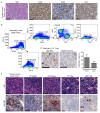HTLV-1 viral oncogene HBZ induces osteolytic bone disease in transgenic mice
- PMID: 29050201
- PMCID: PMC5642476
- DOI: 10.18632/oncotarget.20565
HTLV-1 viral oncogene HBZ induces osteolytic bone disease in transgenic mice
Abstract
Adult T-cell leukemia/lymphoma (ATL) is an aggressive T cell malignancy that occurs in HTLV-1 infected patients. Most ATL patients develop osteolytic lesions and hypercalcemia of malignancy, causing severe skeletal related complications and reduced overall survival. The HTLV-1 virus encodes 2 viral oncogenes, Tax and HBZ. Tax, a transcriptional activator, is critical to ATL development, and has been implicated in pathologic osteolysis. HBZ, HTLV-1 basic leucine zipper transcription factor, promotes tumor cell proliferation and disrupts Wnt pathway modulators; however, its role in ATL induced osteolytic bone loss is unknown. To determine if HBZ is sufficient for the development of bone loss, we established a transgenic Granzyme B HBZ (Gzmb-HBZ) mouse model. Lymphoproliferative disease including tumors, enlarged spleens and/or abnormal white cell counts developed in two-thirds of Gzmb-HBZ mice at 18 months. HBZ positive cells were detected in tumors, spleen and bone marrow. Importantly, pathologic bone loss and hypercalcemia were present at 18 months. Bone-acting factors were present in serum and RANKL, PTHrP and DKK1, key mediators of hypercalcemia and bone loss, were upregulated in Gzmb-HBZ T cells. These data demonstrate that Gzmb-HBZ mice model ATL bone disease and express factors that are current therapeutic targets for metastatic and bone resident tumors.
Keywords: ATL; HBZ; HTLV-1; bone; leukemia.
Conflict of interest statement
CONFLICTS OF INTEREST None
Figures





References
-
- Shimoyama M. Diagnostic criteria and classification of clinical subtypes of adult T-cell leukaemia-lymphoma. A report from the Lymphoma Study Group (1984-87) Br J Haematol. 1991;79:428–37. - PubMed
Grants and funding
LinkOut - more resources
Full Text Sources
Other Literature Sources
Research Materials
Miscellaneous

